 W
WAuschwitz Report (2006) is a non-fiction report on the Auschwitz extermination camp by Primo Levi and Leonardo de Benedetti.
 W
WBergen-Belsen 1945: A Medical Student's Journal is Michael Hargrave's diary of his experiences providing medical assistance to the former inmates of Bergen-Belsen concentration camp between 28 April and 28 May 1945. It was written for his mother after he volunteered for the work while he was a student at Westminster Hospital medical school in London. It is a typescript of the diary, which was originally hand-written, and begins with a foreword by the head of research at the Imperial War Museum and brief background notes by Hargrave's son David. Centre pages include photographs of the London medical students and the state of the camp, including the "human laundry".
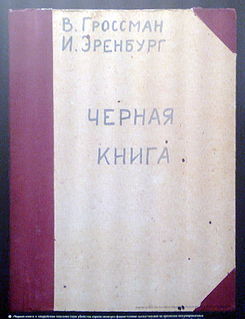 W
WThe Black Book of Soviet Jewry or simply The Black Book, also known as The Complete Black Book of Russian Jewry, is a 500-page book compiled for publication by Ilya Ehrenburg and Vasily Grossman originally in late 1944 in the Russian language. It was a result of the collaborative effort by the Jewish Anti-Fascist Committee (JAC) and members of the American Jewish community to document the anti-Jewish crimes of the Holocaust and the participation of Jews in the resistance movement against the Nazis during World War II. The 1991 Kiev edition of The Black Book was subtitled The Ruthless Murder of Jews by German-Fascist Invaders Throughout the Temporarily-Occupied Regions of the Soviet Union and in the German Nazi Death Camps established on occupied Polish soil during the War 1941–1945.
 W
WBlack Earth: The Holocaust as History and Warning is a 2015 book by historian Timothy D. Snyder.
 W
WBuried by the Times is a 2005 book by Laurel Leff.
 W
WConversations with an Executioner is a book by Kazimierz Moczarski, a Polish writer and journalist, officer of the Polish Home Army who was active in the anti-Nazi resistance during World War II. On 11 August 1945, he was captured and imprisoned in a maximum-security prison by the notorious UB secret police under Stalinism. For a time, he shared the same cell with the Nazi war criminal Jürgen Stroop, who was soon to be executed. They engaged in a series of conversations. The book is a retelling of those interviews.
 W
WDalej jest noc: losy Żydów w wybranych powiatach okupowanej Polski, co-edited by Jan Grabowski and Barbara Engelking, is a two-volume study published in 2018 by the Polish Center for Holocaust Research in Warsaw, Poland. The 1,600-page study contains nine chapters, each covering a county in occupied Poland in 1939–1945—Bielsk Podlaski, Biłgoraj, Bochnia, Dębica, Luków, Miechów, Nowy Targ, Węgrów, and Złoczów—in the General Government area established by Germany in World War II. The study identifies small Polish towns as "death traps" for Jews in hiding. An abridged English-language version of the study is forthcoming.
 W
WDenying the Holocaust: The Growing Assault on Truth and Memory is a 1993 book by the historian Deborah Lipstadt, in which the author discusses the Holocaust denial movement. Lipstadt named British writer David Irving as a Holocaust denier, leading him to sue her unsuccessfully for libel. She gives a detailed explanation of how people came to deny the Holocaust or claim that it was vastly exaggerated by the Jews.
 W
WThe Destruction of the European Jews is a 1961 book by historian Raul Hilberg. Hilberg revised his work in 1985, and it appeared in a new three-volume edition. It is largely held to be the first comprehensive historical study of the Holocaust. According to Holocaust historian, Michael R. Marrus, until the book appeared, little information about the genocide of the Jews by Nazi Germany had "reached the wider public" in both the West and the East, and even in pertinent scholarly studies it was "scarcely mentioned or only mentioned in passing as one more atrocity in a particularly cruel war".
 W
WEichmann in Jerusalem: A Report on the Banality of Evil is a 1963 book by political theorist Hannah Arendt. Arendt, a Jew who fled Germany during Adolf Hitler's rise to power, reported on the trial of Adolf Eichmann, one of the major organizers of the Holocaust, for The New Yorker. A revised and enlarged edition was published in 1964.
 W
WEichmann Interrogated is a 1982 non-fiction book containing selections from the pre-trial interrogation of high-ranking former Nazi official Adolf Eichmann.
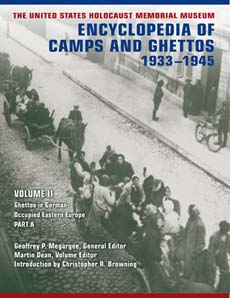 W
WEncyclopedia of Camps and Ghettos, 1933–1945 is a seven-part encyclopedia series that explores the history of the concentration camps, ghettos, forced-labor camps, and other sites of detention, persecution, or state-sponsored murder run by Nazi Germany and other Axis powers in Europe and Africa. The series is produced by the United States Holocaust Memorial Museum (USHMM) and published by Indiana University Press. Research began in 2000; the first volume was published in 2009; and the final volume is slated for publication in 2025. Along with entries on individual sites, the encyclopedias also contain scholarly overviews for historical context.
 W
WFear: Anti-Semitism in Poland after Auschwitz: An Essay in Historical Interpretation, is a book by Jan T. Gross, published by Random House and Princeton University Press in 2006. An edited Polish version was published in 2008 by Znak Publishers in Krakow as Strach: antysemityzm w Polsce tuż po wojnie: historia moralnej zapaści. In the book, Gross explores the issues concerning incidents of post-war anti-Jewish violence in Poland, with particular focus on the 1946 Kielce pogrom. Fear has received international attention and reviews in major newspapers; receiving both praise and criticism.
 W
WFinale der Vernichtung. Die Einsatzgruppe H in der Slowakei 1944/1945 (2013) is a book by Czech historian Lenka Šindelářová based on her doctoral thesis at the University of Stuttgart. It was also published in Czech as Einsatzgruppe H: působení operační skupiny H na Slovensku 1944/1945 a poválečné trestní stíhání jejích příslušníků (2015).
 W
WGates of Tears: the Holocaust in the Lublin District is the first comprehensive study of the Holocaust in the Lublin District of Poland. It was written by David Silberklang and published in 2013 by Yad Vashem.
 W
WThe German War: A Nation Under Arms, 1939-1945 is a non-fiction book written by historian Nicholas Stargardt. Centering upon the "thoughts and actions" of the citizens living inside Nazi Germany during the Second World War, the author argues that the war crimes committed by Adolf Hitler's totalitarian state had widespread awareness among regular people. Despite massive hardship, those citizens continued to fight in support of fascist ideology even when their cause appeared truly lost. Much of the moral callousness arose due to the fallout from the First World War, which impacted regular Germans' lives deeply, yet the far-right dictatorship had fundamentally managed a successful propaganda machine that brought mass public opinion onto the side of the hateful regime.
 W
WGolden Harvest is a 2011 book about the Holocaust in Poland. It was written by historians Jan T. Gross and Irena Grudzińska-Gross. It was first published in Polish in March 2011, with an English translation following in 2012.
 W
WThe Greater German Reich and the Jews: Nazi Persecution Policies in the Annexed Territories 1935–1945 is a book about the Holocaust in areas annexed by Nazi Germany. The book's chapters are arranged in chronological order by annexation date and cover the Saarland, Austria, the Sudetenland, Protectorate of Bohemia and Moravia, Memel Territory, Danzig and West Prussia, the Warthegau, Zichenau, East Upper Silesia, Eupen-Malmedy, Luxembourg, and Alsace-Lorraine. It was first published in German in 2010; an English translation was published in 2015. The book was edited by Jörg Osterloh and Wolf Gruner. The book received generally favorable reviews.
 W
WGun Control in the Third Reich is a non-fiction book by lawyer Stephen Halbrook. It describes the gun control policies used in Germany from the 1918 Weimar Republic, through the Third Reich in 1938. The book aims to substantiate the Nazi gun control theory of gun politics in the United States by referencing German archives, diaries, and newspapers that attest to restrictions on firearm ownership for Jews and enemies of the state. It is published by the Independent Institute
 W
WHitler’s Bandit Hunters: The SS and the Nazi Occupation of Europe is a 2006 book by the British author and researcher Philip W. Blood. It discusses the evolution of German rear security policies during World War II, from Partisanenkreig to Bandenbekämpfung, leading to mass crimes against humanity and genocide.
 W
WHitlerland: American Eyewitnesses to the Nazi Rise to Power is a 2012 book by the journalist Andrew Nagorski.
 W
WHitler's Willing Executioners: Ordinary Germans and the Holocaust is a 1996 book by American writer Daniel Goldhagen, in which he argues that the vast majority of ordinary Germans were "willing executioners" in the Holocaust because of a unique and virulent "eliminationist antisemitism" in German political culture which had developed in the preceding centuries. Goldhagen argues that eliminationist antisemitism was the cornerstone of German national identity, was unique to Germany, and because of it ordinary German conscripts killed Jews willingly. Goldhagen asserts that this mentality grew out of medieval attitudes rooted in religion and was later secularized.
 W
WThe Holocaust in Bohemia and Moravia: Czech Initiatives, German Policies, Jewish Responses is a book by the German historian Wolf Gruner on the Holocaust in Bohemia and Moravia, the Czech-majority parts of Czechoslovakia partially annexed into Nazi Germany during the German occupation of Czechoslovakia. Beginning before the Munich Agreement, Gruner's book covers the various stages of persecution of Jews which led to their deportation and murder. He argues that the role of Czech collaboration and local initiatives was greater than has been conventionally assumed, and also that Jewish resistance to persecution was substantial. The book has received mixed reviews; some Czech historians have disagreed with Gruner's conclusions while other reviewers generally praised the book with some reservations. The book was published in German in 2016 and in English and Czech in 2019. It received the 2017 Sybil Halpern Milton Memorial Book Prize of the German Studies Association.
 W
WThe Holocaust in Croatia (2016) is a book by Ivo and Slavko Goldstein, first published as Holokaust u Zagrebu in 2001. It received positive reviews in English-language publications, and was praised for its evenhanded and nuanced approach to controversial subject matter. It was a finalist for the National Jewish Book Award.
 W
WHunt for the Jews: Betrayal and Murder in German-Occupied Poland is a 2013 book about the Holocaust in Poland by Jan Grabowski. The 2013 English edition followed a 2011 Polish-language edition and was in turn followed by a 2016 Hebrew edition.
 W
WIBM and the Holocaust: The Strategic Alliance between Nazi Germany and America's Most Powerful Corporation is a book by investigative journalist Edwin Black which details the business dealings of the American-based multinational corporation International Business Machines (IBM) and its German and other European subsidiaries, with the government of Adolf Hitler during the 1930s through World War II. Published in 2001, Black outlined the key role of IBM's technology in the Nazi genocide, by facilitating the regime's generation and tabulation of punch cards based upon national census data.
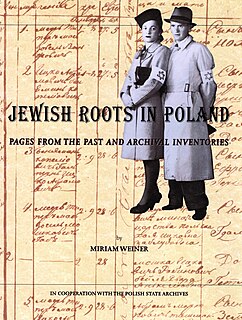 W
WJewish Roots in Poland is a book created by genealogist Miriam Weiner and co-published by The Miriam Weiner Routes to Roots Foundation and YIVO Institute for Jewish Research. A searchable database of updated archival holdings listed in the book is available in the Archive Database on the Routes to Roots Foundation website.
 W
WJewish Roots in Ukraine and Moldova is a book created by genealogist Miriam Weiner and co-published by The Miriam Weiner Routes to Roots Foundation and YIVO Institute for Jewish Research. A searchable database of updated archival holdings listed in the book is available in the Archive Database on the Routes to Roots Foundation website.
 W
WKL: A History of the Nazi Concentration Camps is a 2015 book by Birkbeck College professor Nikolaus Wachsmann.
 W
WThe Lampshade: A Holocaust Detective Story from Buchenwald to New Orleans is a 2010 nonfiction book by U.S. author Mark Jacobson. It recounts the attempt to ascertain the origin of a lampshade purportedly made from human skin. It was not until 2012 that DNA testing was sophisticated enough to determine that the shade was likely made from a parchment of cow skin.
 W
WThe Lemberg Mosaic, subtitled the "Memoirs of Two who Survived the Destruction of Jewish Galicia," is a book on the Holocaust by Jakob Weiss. This work brings to light the relatively obscure history of the systematic and total destruction of Jewish Lemberg. It is presented in the format of a biography, detailing the struggle for survival of four families in the backdrop of two back-to-back invasions of the city and surrounding region by both the Soviets (1939) and the Germans (1941).
 W
WA Moral Reckoning: The Role of the Catholic Church in the Holocaust and Its Unfulfilled Duty of Repair is a 2003 book by the political scientist Daniel Jonah Goldhagen, previously the author of Hitler's Willing Executioners (1996). Goldhagen examines the Roman Catholic Church's role in the Holocaust and offers a review of scholarship in English addressing what he argues is antisemitism throughout the history of the Church, which he claims contributed substantially to the persecution of the Jews during World War II.
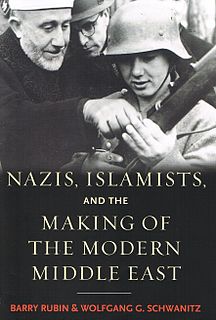 W
WNazis, Islamists, and the Making of the Modern Middle East is a controversial 2014 Yale University Press book by German historian Wolfgang G. Schwanitz and Israeli historian Barry Rubin. The authors argue that there is a high degree of similarity in the ideologies of Nazism, radical Arab nationalism, and Islamism. The book received a mixed reception with some historians criticizing the authors' methodology and conclusions.
 W
WNone Is Too Many: Canada and the Jews of Europe 1933–1948 is a 1983 book co-authored by the Canadian historians Irving Abella and Harold Troper. The book is about Canada's restrictive immigration policy towards Jewish refugees during the Holocaust years. The book helped popularize the phrase "none is too many" in Canada.
 W
WPerfidy is a book written by Ben Hecht in 1961. The book describes the events surrounding the 1954–1955 Kastner trial in Jerusalem.
 W
WThe Persecution and Murder of the European Jews by Nazi Germany, 1933–1945 is a German book series that contains documents relating to the Holocaust, edited and translated, with scholarly introductions by historians.
 W
WPinkas haKehillot or Pinkas Ha-kehilot, Encyclopedia of Jewish Communities from Their Foundation till after the Holocaust, is the name of each volume of a series presenting collected historical information and demographic data on Eastern European countries' Jewish communities, most of which were depopulated and whose populations were exterminated in the Holocaust. Pinkasei haKehillot is one of the most important projects undertaken by Yad Vashem in Jerusalem, concisely documenting this aspect of the history of the Holocaust.
 W
WThe Pity of It All: A Portrait of Jews In Germany 1743 – 1933 is a 2002 book by Amos Elon. The book describes the history of the German Jews between the years 1743 - 1933. The book's narrative focuses on the constant efforts of the German Jews to assimilate and become an integral part of their host country. This journey ends with the tragic outcome of the virtual annihilation of the German Jews during the Holocaust.
 W
WThe Pope's Dilemma: Pius XII Faces Atrocities and Genocide in the Second World War (2015) is a book by Canadian historian Jacques Kornberg which examines Pope Pius XII and the Holocaust, a controversial topic. Kornberg is moderately critical of the pope, especially for the lack of public statements of Pope Pius XII on the Holocaust. According to Kornberg, the pope's priority was keeping Nazi-sympathizing Catholics in the fold and maintaining his influence in Catholic countries. The book received mostly positive reviews in academic publications.
 W
WThe Scourge of the Swastika: A Short History of Nazi War Crimes is a 1954 non-fiction book by Edward Russell, 2nd Baron Russell of Liverpool.
 W
WSecret City: The Hidden Jews of Warsaw 1940–1945 is a 2002 book by Gunnar S. Paulsson. It was translated to Polish in 2008. Secret City is a social history of the Jews who escaped from the Warsaw Ghetto and tried to survive, living illegally "on the Aryan side". The book has received mostly favourable reviews, with several historians calling it "significant", "a milestone" and “riveting study".
 W
WSix Million Crucifixions: How Christian Teachings About Jews Paved the Road to the Holocaust is a 2010 history book by author Gabriel Wilensky. The book examines the role Christian teachings about Jews played in enabling the racial eliminationist antisemitism that gave rise to the Holocaust. In Six Million Crucifixions Wilensky argues that from the earliest days of the Christian movement an attitude of contempt toward Jews and Judaism emerged, which over time evolved into full-blown hatred. Wilensky argues that it was this foundation that made the various peoples of Europe ultimately receptive to the genocidal message of the Nazis, and made large numbers of them willing collaborators in the extermination of two thirds of European Jewry in what is known as the Holocaust.
 W
WSoldiers and Slaves: American POWs Trapped by the Nazis' Final Gamble is a 2005 history of World War II by New York Times reporter Roger Cohen. It recounts the ordeals suffered by the 550 American prisoners of war shipped into eastern Germany during the winter of 1944–1945.
 W
WThe Storm of War is a non-fiction book authored by British historian and journalist Andrew Roberts. It covers numerous historical factors of the Second World War such as Adolf Hitler's rise to power and the organisation of Nazi Germany as well as numerous missteps made by the dictatorial regime. The inherent failures of the Axis powers helped in the massive efforts to force their defeat, which constitutes in Roberts' opinion, despite the massive bloodshed during the war, a moral triumph over authoritarianism by idealistic democracy. Praise has come from several publications; examples include The Daily Beast, The Economist. and The Observer.
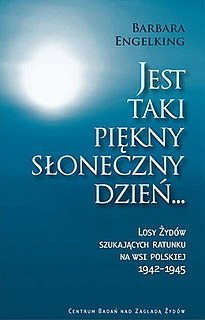 W
WSuch a Beautiful Sunny Day: Jews Seeking Refuge in the Polish Countryside, 1942–1945 is a 2016 book by Polish historian Barbara Engelking. It was first published in Polish in 2012 as Jest taki piękny, słoneczny dzień: Losy Żydów szukających ratunku na wsi polskiej 1942–1945. It focuses on the subject matter of The Holocaust in Poland.
 W
WThe Transfer Agreement: The Dramatic Story of the Pact Between the Third Reich and Jewish Palestine is a book written by author Edwin Black, documenting the transfer agreement between Zionist organizations and Nazi Germany to transfer a number of Jews and their assets to Palestine. Shortly after Samuel Untermyer's return to the U.S. from Germany in 1933, articles appeared on the front page of newspapers in London and New York declaring that "Judea declares war on Germany". This resulted in an effective boycott of German goods in many countries, affecting German exports significantly. The agreement was partly inspired by this boycott which appeared to threaten the Reich. Controversial as it may be seen in hindsight, it marked one of the few rescues of Jews and their assets in the years leading up to the Holocaust.
 W
WUniversity over the Abyss is a book about the educational and cultural life in the Terezín ghetto. Authors Elena Makarova, Sergei Makarov and Viktor Kuperman have searched available archives, interviewed survivors worldwide and compiled the definitive summary of this nominally illegal but extensive phenomenon that included formal lectures, poetry readings, concerts, storytelling sessions and theatrical and opera performances, all in a setting that was a holding place for prisoners who were ultimately on their way to the Auschwitz-Birkenau extermination camp.
 W
WVanished History: The Holocaust in Czech and Slovak Historical Culture is a 2014 book by Czech academic Tomas Sniegon of Lund University, Sweden, which addresses the memory and commemoration of the Holocaust in the Czech Republic and Slovakia.
 W
WVengeance and Retribution Are Mine: Community, the Holocaust, and Abba Kovner's Avengers is a book by Israeli historian Dina Porat on Nakam, a small group of Holocaust survivors led by Abba Kovner which sought violent revenge against Germans. She chose the title to express her belief that humans should leave revenge for God. It was first published in 2019 by Pardes Publishing / Haifa University Press in Hebrew, and is the first scholarly book on Nakam.
 W
WThe Volunteer: The True Story of the Resistance Hero Who Infiltrated Auschwitz is a 2019 book which presents detailed research by British writer Jack Fairweather, a former Washington Post war correspondent, into the life of Witold Pilecki. The new material about the Polish army officer and partisan reached Fairweather in 2011 when he heard about "a band of Polish resisters who had repeatedly risked death to get accurate documentation about the killings in Auschwitz to the underground in Warsaw and from there to the Allies in London."
 W
WVoyage of the Damned is a 1976 war drama film directed by Stuart Rosenberg, with an all-star cast featuring Faye Dunaway, Oskar Werner, Lee Grant, Max von Sydow, James Mason, and Malcolm McDowell.
 W
WThe War Against the Jews is a 1975 book by Lucy Dawidowicz. The book researches the Holocaust of the European Jewry during World War II.
 W
WThe Warsaw Ghetto: A Guide to the Perished City is a 2009 book by Barbara Engelking and Jacek Leociak. It was first published in Polish in 2001 as Getto warszawskie. Przewodnik po nieistniejącym mieście. The book focuses on the Warsaw Ghetto.
 W
WWhere Once We Walked, compiled by noted genealogist Gary Mokotoff and Sallyann Amdur Sack with Alexander Sharon, is a gazetteer of 37,000 town names in Central and Eastern Europe focusing on those with Jewish populations in the 19th and first half of the 20th centuries and most of whose Jewish communities were almost or completely destroyed during The Holocaust.
 W
WA World Without Jews: The Nazi Imagination from Persecution to Genocide is a 2014 book by Alon Confino published by Yale University Press, which seeks to explain Nazi antisemitism and the Holocaust by looking into the imaginations and fantasies of Nazis. It received mixed reviews in scholarly and popular publications. Some reviewers praised Confino's analysis for its originality, while others criticize it for making assertions that are not sufficiently backed by evidence.
 W
WThe Years of Extermination: Nazi Germany and the Jews, 1939–1945 is the second volume of Saul Friedländer's history of Nazi Germany and the Jews. It describes the German extermination policies that resulted in the murder of six million European Jews. The book presents a detailed history of the Holocaust and is based on a vast array of documents and memoirs. It won the 2007 Leipzig Book Fair Prize for Non-fiction and won the Pulitzer Prize for General Non-Fiction in 2008.
 W
WThe Zookeeper's Wife is a non-fiction book written by the poet and naturalist Diane Ackerman. Drawing on the unpublished diary of Antonina Żabińska, it recounts the true story of how Antonina and her husband, Jan Żabiński, director of the Warsaw Zoo, saved the lives of 300 Jews who had been imprisoned in the Warsaw Ghetto following the German invasion of Poland on September 1, 1939. The book was first published in 2007 by W. W. Norton.